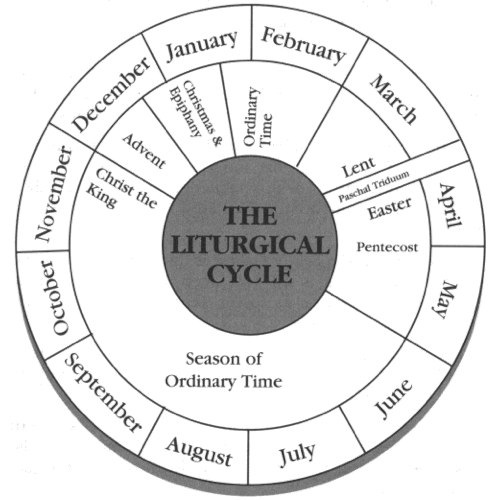People mark time in different ways. Some of us carry a physical calendar with us to keep track of events and appointments. Others use a virtual one on our cell phones. Some have four seasons and all the delightful changes each one brings. Others live in a temperate climate all year round and have to watch for subtler changes in nature that tell us what time of year it is.
Not surprisingly, our spiritual lives are structured in ways that mark time as well. Both Pagans and Christians have rites that celebrate significant life events such as birth, coming of age, marriage, death, etc. Then there are the “spiritual calendars” both groups keep that take us through the cycle of the year. Not surprisingly, both of these calendars connect with one another in significant ways.
Most modern Pagans follow the “Wheel of the Year” which is an annual cycle of eight seasonal festivals. Wiccans call these sabbats (from the Greek word “sabatu” which means “to rest.”)

Four of the sabbats fall on the solstices and equinoxes of the year and are referred to as “quarter days.” They include Yule, Ostara, Midsummer, and Mabon. The other four occur on the midpoints between the other four and are referred to as “cross quarter days.” They include Imbolc, Beltane, Lughnasadh and Samhain. All of these sabbats are deeply tied to the cycle of the seasons in the Northern Hemisphere. These sabbats are rich with agricultural and natural imagery where the change of seasons reflect various aspects of our spiritual lives such as rebirth, growth, maturity, and dormancy.
Many modern Christians follow the “Liturgical Calendar” which, surprise, surprise, is also in the shape of a wheel! This calendar follows mostly follows the life of Jesus and contains the seasons of Advent. Christmas, Epiphany, Lent, Easter and Ordinary Time. While Advent always begins four Sundays before December 25th, Easter is a moveable feast that occurs on the first Sunday after the Paschal Full Moon, falling on or after the Spring Equinox (March 21). Once the date for Easter is established, then the days of Lent through Pentecost fall into place.

I see several very deep connections between these two ways of marking spiritual time. For Christians, Advent is a season of waiting for the light to appear, that light being Jesus whose actual birth date is unknown. December 25th was chosen because it coincided with other Pagan celebrations surrounding the winter solstice such as the Roman Saturnalia and the Pagan Yule. Both of these observances are also festivals of light and the connection between these and the themes of Advent and Christmas are too numerous to mention in this post.
The second big connection is that the Lent/Easter season traces Jesus’ death and resurrection. Its most powerful spiritual theme is dying to destructive ways of living and rising to new life. This fits perfectly with the themes of Imbolc (which speaks of seeds dying and rooting/transforming so that new life can emerge in the spring) and Ostara (which is all about fertility, birth and the new life that is blooming everywhere).
Well, that gets us started. Both of these spirituals calendars are powerful ways of thinking about our ives and our connection with the Divine and each other.
Copyright ©2022 by David Taliesin, http://www.sabbatsandsabbaths.com.

Hi David. I love your blog, which I just discovered today.
I was curious about your comment that Easter is the first Sunday after the Spring Equinox because I remembered reading it had something to do with the Full Moon. FYI, Wikipedia says
“The date of Easter is determined as the first Sunday after the “paschal full moon” falling on or after the Spring Equinox (March 21). This “full moon” does not currently correspond directly to any astronomical event, but is instead the 14th day of a lunar month, determined from tables. It may differ from the date of the actual full moon by up to two days. [Montes, Marcos J. “Calculation of the Ecclesiastical Calendar” Retrieved on 2008-01-12]”
Happy Ostara!
LikeLike
Glad you’re enjoying the blog. My comment was meant for this year because Easter is the first Sunday after the Spring Equinox this year. Sorry for the confusion. We are both correct in this case! Blessed be.
LikeLike
Oh I looked at the post you commented on and see what you mean. I made the correction. Thanks for catching it!
LikeLike
On the establishing of the date of 25th December as the feast of the Nativity, I suggest there is an alternate view than that it was chosen because of coinciding with Pagan festivals. Andrew McGowan, (for example, see here: http://abmcg.blogspot.com/2008/12/dating-christmas.html ) makes an argument that the date was chosen because of its relationship to other significant dates in the liturgical calendar; and also that these dates were established in the very early church, while the fashion was still to avoid Pagan associations rather than co-opt them.
LikeLike
Thanks for an alternate perspective. I will definitely look into it.
LikeLike